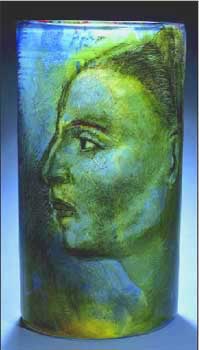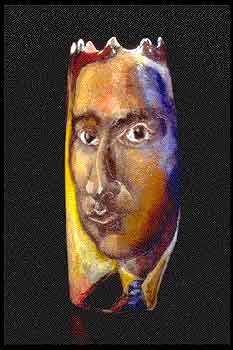WD40+:
The Painted Glass and Prints Walter Lieberman of and Dick Weiss"
by Shawn Waggoner
Glass Art Magazine11/12 2002
(page 3)
PUBLICATIONS
Weiss continues, “Walt needed to loosen up, and I needed to tighten up. We met in the middle,and it was beneficial to both of us. Suzanne Frantz,former curator of Modern Art at The Corning Museum of Glass, thought our joint work was better than either of our individual work. Together we became a third person with the right balance for the application of paint.”
Though their styles
differ, they share a love of painting on glass, both on flat sheets and
vessel forms.
Thematically they are driven by psychological and emotional portraiture.The
human head and face are vitally important to each artist.
One painted vessel from 1995,“Our Soldier, Our Father,” depicts a portrait of Weiss ’ father retiring from the Army on one side, and Lieberman ’s father graduating from law school on the other side. They used these images in a series of prints as well.
Working from photographs of the two men ’s dads,enamel inks were mixed to the consistency of printer ’s ink and applied to the vessel with a brush. Using a variety of tools (Q-tips,sticks), they scraped away the ink while wet a process very similar to that of monotype print-making. Lieberman wants to fire more, and Weiss wants to fire less. This piece was fired several times. Between each firing,they applied more paint until the perfected image was captured.
“This piece strikes my heart,” says Lieberman.“It seems deep and genuine.”

La Ciervo, WD40+, 22 x 10
enamels fired on blown glass,1996
Vessel by Ben Moore photo: Roger Schreiber

“Our Soldier,Our Father,” WD40+
22" x 12 ” enamels on blown glass,1996
Vessel by Ben Moore, photo: Roger Schreiber.
The vessels on which Lieberman and Weiss paint their images are blown by none other than the cream of the crop Ben Moore, Dante Marioni or Janusz Pozniak who are Walt and Dick ’s friends.
“Neither Dick nor I could possibly make these things ourselves,” says Lieberman. These guys,our friends,obviously have their own fabulous careers and are very busy.They do it out of friendship and occasionally trades. But the fact that they want to take time to help us is something that we really appreciate.They ’re very generous.”
Says Weiss,“Having a group of friends in the rowboat that you can turn to has been a real blessing for the last 20 years.They have done everything from give opinions to help row the boat.”
Another vessel form,“La Ciervo,” reveals an adaptation of Renaissance portraiture,and reflects a very painterly approach to the background.
“I ’m scared of backgrounds and usually fill the space with my subject,” says Weiss. “Working with Walt freed me up to just go with it and see what happened the freedom to do something would have been too worried to do on my own.”
The artists,inspired by Renaissance painting,have interpreted many portraits from that period in their individual work as well as with WD40+. They say jokingly,“We copy the best.” This process is both apprenticeship and homage.The artists freely interpret the images faces that touch their hearts or reflect psychological dilemmas.